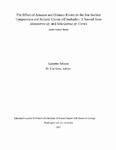| dc.rights.license | In Copyright | en_US |
| dc.creator | Telfeyan, Katherine C. | |
| dc.date.accessioned | 2010-08-05T15:31:59Z | |
| dc.date.created | 2010 | |
| dc.identifier | WLURG38_Telfeyan_GEOL_2010 | |
| dc.identifier.uri | http://hdl.handle.net/11021/16428 | |
| dc.description | Thesis; [FULL-TEXT FREELY AVAILABLE ONLINE] | en_US |
| dc.description | Katherine C. Telfeyan is a member of the Class of 2010 of Washington and Lee University. | en_US |
| dc.description.abstract | Four Mantastrea sp. coral cores and four Siderastrea sp. coral cores were collected from the west coast of Barbados in June-July 2009. Samples were cut [at] Washington and Lee University in Lexington, Virginia and x-rayed at the Virginia Institute of Marine Sciences in Williamsburg, Virginia to determine coral growth rates. They were then drilled with a micromill and prerared for δ[superscript 18]O, δ[superscript 13]C and Sr/Ca analyses. This study attempts to extract a salinity signal using δ[superscript 18]O and Sr/Ca from coral carbonate. Incorporation of Sr/Ca into coral skeleton is known to only be affected by ambient temperature, while δ[superscript 18]O is affected by both temperature and salinity. Calculated temperature and salinity measurements from each coral were compared with in situ temperature data provided by the National Oceanic and Atmospheric Administration and the Coastal Zone Management of Barbados. The data indicate that the southwest coast of Barbados provides the best record of sea surface temperature and salinity changes. The results also show a steady increase in temperature since 1988. Annual temperature and salinity maxima and minima align with the peak outflow of the Amazon and Orinoco Rivers, which arrive at Barbados in August. This study shows the utility of δ[superscript 18]O and Sr/Ca in determining temperature and salinity, though error in Sr/Ca data prevents a full salinity record. δ[superscript 13]C measurements and lack of a resolved salinity signal in the Siderastrea sp. indicate the species' relative inability to accurately record sea surface salinity and temperature. With increased global ocean acidification and the influx of less saline, more acidic water from the Amazon and Orinoco Rivers, the health of Bajan corals may suffer. | en_US |
| dc.description.statementofresponsibility | Katherine Telfeyan | |
| dc.format.extent | 97 pages | en_US |
| dc.language.iso | en_US | en_US |
| dc.rights | This material is made available for use in research, teaching, and private study, pursuant to U.S. Copyright law. The user assumes full responsibility for any use of the materials, including but not limited to, infringement of copyright and publication rights of reproduced materials. Any materials used should be fully credited with the source. | en_US |
| dc.rights.uri | http://rightsstatements.org/vocab/InC/1.0/ | en_US |
| dc.subject.other | Washington and Lee University -- Honors in Geology | en_US |
| dc.title | The Effect of Amazon and Orinoco Rivers on the Sea Surface Temperature and Salinity Cycles off Barbados: A Record from Montastrea sp. and Siderastrea sp. Corals (thesis) | en_US |
| dc.type | Text | en_US |
| dcterms.isPartOf | RG38 - Student Papers | |
| dc.rights.holder | Telfeyan, Katherine C. | |
| dc.subject.fast | Ocean temperature -- Research | en_US |
| dc.subject.fast | Ocean salinity | en_US |
| dc.subject.fast | Barbados | en_US |
| dc.subject.fast | Isotope geology | en_US |
| dc.subject.fast | Corals -- Effect of temperature on | en_US |
| local.department | Geology | en_US |
| local.scholarshiptype | Honors Thesis | en_US |
